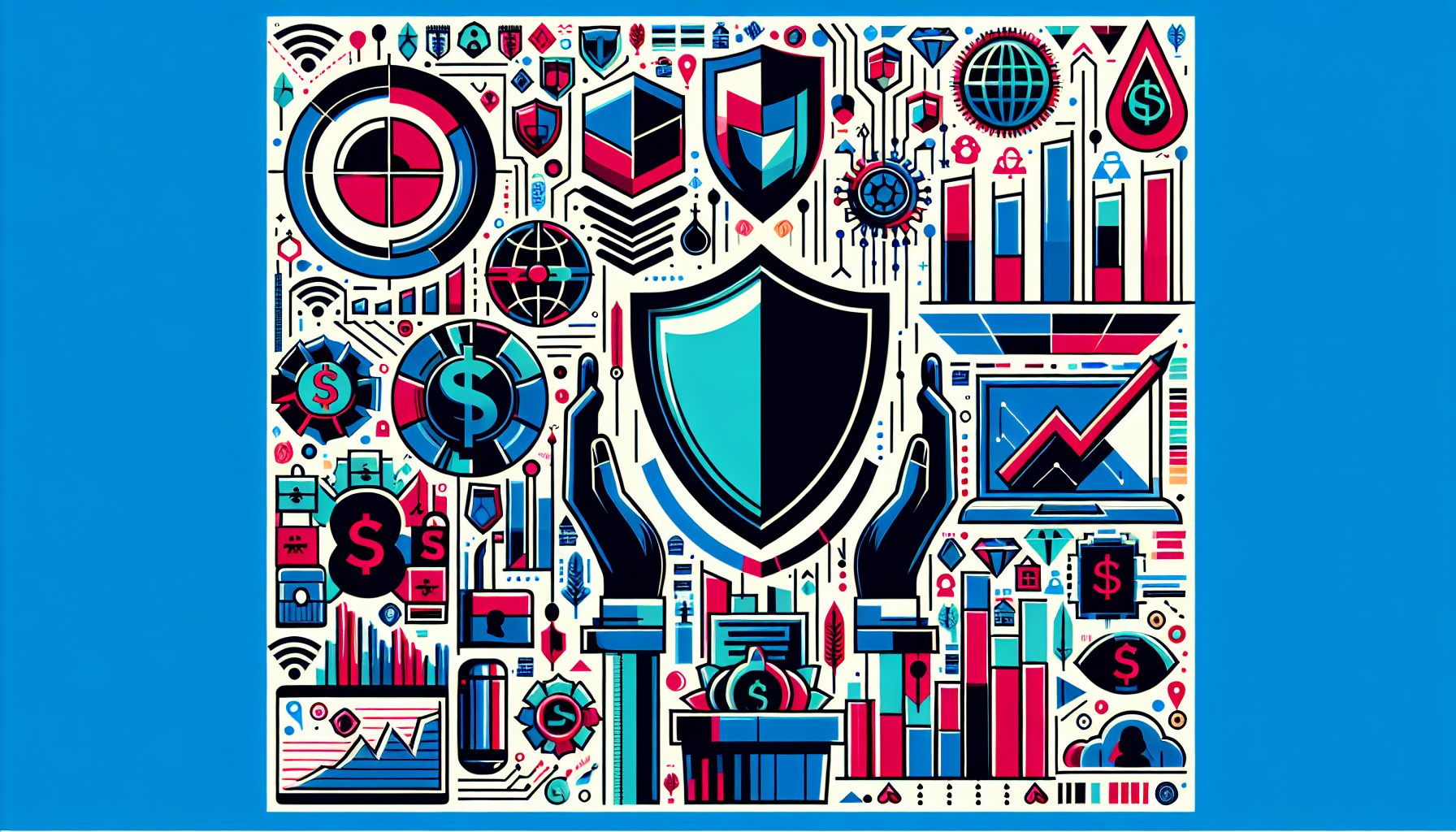Navigating the Digital Era: The Growing Importance of Cybersecurity in Financial Markets

Understanding Financial Markets
Financial markets are complex systems where individuals, businesses, and governments participate in the trading of financial securities, commodities, and other items of value at low transaction costs and at prices that reflect supply and demand. For beginner investors venturing into this domain, grasping the fundamental dynamics and the variety of investment types is essential.
Market Dynamics
Market dynamics in the financial world are influenced by a multitude of factors, including economic indicators, company news, geopolitical events, and, increasingly, cybersecurity incidents. The financial services industry is the most targeted sector for cyber incidents, which can disrupt market stability and erode investor confidence.
The rise of digital transformation in finance has introduced both opportunities and risks, with cyber threats becoming a significant concern. Market dynamics are also shaped by global economic shifts (global economic shifts and their impact on financial markets), regulatory changes (regulatory trends shaping the future of finance), and the emergence of new technologies (emerging technologies in finance: blockchain, ai, and beyond).
Investment Types
Investment types in financial markets vary widely, providing options to suit different risk profiles, time horizons, and financial goals. Common categories include:
- Stocks: Shares of ownership in a company.
- Bonds: Debt securities issued by entities such as governments or corporations.
- Mutual Funds: Investment programs funded by shareholders that trade in diversified holdings.
- Exchange-Traded Funds (ETFs): Similar to mutual funds but traded on stock exchanges.
- Options: Contracts that give the investor the right, but not the obligation, to buy or sell an asset at a predetermined price.
- Futures: Contracts to buy or sell an asset at a future date at a price agreed upon today.
Beyond traditional investment vehicles, the landscape includes cryptocurrencies, sustainable finance, decentralized finance, and other innovative financial instruments like peer-to-peer lending.
Investors new to the financial markets should consider their investment objectives and seek education on the various types of investments available. Awareness of the growing importance of cybersecurity in financial markets is also critical, as it directly impacts the integrity and functioning of financial systems.
The Role of Cybersecurity
As the financial sector continues to intertwine with digital technologies, the role of cybersecurity becomes ever more critical. Cybersecurity measures are essential to safeguard sensitive financial data against unauthorized access and cyber threats that can disrupt the stability of financial markets.
Recent Cyberattacks
The financial industry has seen a dramatic surge in cyberattacks, with a 238% increase in attacks targeting financial institutions in the first half of 2020 alone (UpGuard). These attacks are not only growing in number but also in sophistication, as cybercriminals employ tactics like phishing, ransomware, and advanced persistent threats (APTs) to compromise the integrity of financial systems.
A notable trend is the rise in phishing attacks, which have increased by 22% in early 2021 compared to the same period in the previous year. Moreover, between March and June 2020, phishing and ransomware attacks targeting banks escalated by 520% compared to the same period in 2019, with ransomware attacks alone jumping by 151% in the first half of 2021 (UpGuard).
Costs and Consequences
The financial repercussions of cyberattacks in the financial sector are staggering. In 2021, the average cost of a data breach in the financial sector was $5.72 million (IBM and the Ponemon Institute). But the impact extends beyond just monetary loss. Financial institutions face reputational damage, regulatory scrutiny, and eroded customer trust, which can have long-lasting effects.
The consequences are not limited to individual institutions either; they can have systemic implications, affecting market stability and investor confidence. Over 90% of successful cyberattacks start with phishing, indicating that human factors are often the weakest link in cybersecurity defenses.
| Cyber Threat | Percentage Increase | Period |
|---|---|---|
| Phishing Attacks | 22% | Early 2021 vs. Early 2020 |
| Ransomware Attacks | 151% | First Half of 2021 vs. First Half of 2020 |
| Attacks Targeting Banks | 520% | March-June 2020 vs. March-June 2019 |
These figures underscore the growing importance of cybersecurity in financial markets, and the need for financial institutions to implement robust cybersecurity strategies and leverage emerging technologies (SubRosa Cyber).
As financial markets continue to evolve with the future of cryptocurrency, the rise of decentralized finance (DeFi), and the integration of fintech innovations, the imperative for stringent cybersecurity measures grows. Understanding the costs and consequences of cyberattacks is a crucial step towards fortifying the financial sector against the ever-evolving landscape of cyber threats.
Protecting Financial Data
In the current landscape where financial institutions are prime targets for cybercriminals, protecting financial data has become paramount. The sophistication of cyber threats requires a multifaceted approach to cybersecurity, combining strategic measures with cutting-edge technological solutions.
Cybersecurity Strategies
Financial institutions face a myriad of cyber threats, including phishing, ransomware, and insider attacks. To combat these, a robust cybersecurity framework is essential. Key components of this framework, as outlined by SubRosa Cyber, include:
- Conducting Risk Assessments: Regularly identifying and evaluating potential vulnerabilities within the financial ecosystem.
- Security Awareness Training: Equipping employees with the knowledge to recognize and thwart cyber threats.
- Incident Response Plans: Preparing for potential breaches with a clear, actionable strategy.
- Regular System Updates: Ensuring that all software and infrastructure are up to date with the latest security patches.
- Multi-factor Authentication (MFA): Adding an extra layer of security for accessing sensitive systems and data.
Financial institutions are investing heavily to safeguard their systems and data, as the industry has become the most targeted sector for cyber incidents, according to Data Dynamics Inc.. These security measures are not just about protecting individual entities but also about maintaining the stability and integrity of the global financial markets.
Technology and Innovation
Innovative technologies are at the forefront of the battle against cybercrime in the financial sector. Financial institutions are leveraging advancements such as:
- Artificial Intelligence (AI) and Machine Learning (ML): For predictive threat detection and real-time monitoring of anomalous activities.
- Blockchain: To secure transactions and enhance the integrity of financial records.
- Biometric Authentication: Utilizing unique biological traits for identity verification and access control.
The integration of these technologies into financial cybersecurity strategies provides a more dynamic and resilient defense mechanism against the constantly evolving cyber threats. With the financial industry being attacked more than any other in 2023, as reported by Data Dynamics Inc., the role of technological innovation in cybersecurity cannot be overstated.
The digital transformation of financial markets is both a boon and a challenge, driving the need for enhanced cybersecurity measures. As emerging technologies continue to shape the financial landscape, from the future of cryptocurrency to decentralized finance (DeFi), the sector must remain vigilant and proactive in its cybersecurity efforts. Continuous collaboration with cybersecurity experts and adherence to regulatory compliance will be pivotal in ensuring the safety and trust of investors in the financial markets.
Regulatory Compliance
As financial markets continue to interlace with the digital realm, regulatory compliance in cybersecurity becomes imperative to safeguard the integrity and stability of the financial sector. Specific regulations are designed to buttress data privacy, consumer protection, and cybersecurity resilience within the industry.
Key Regulations
Several key regulations have been established worldwide to address the growing importance of cybersecurity in financial markets. In the United States, the Gramm-Leach-Bliley Act (GLBA) sets the benchmark for protecting consumer information held by financial institutions. It mandates that companies explain their information-sharing practices to their customers and safeguard sensitive data SubRosa Cyber.
In the European Union, the General Data Protection Regulation (GDPR) underscores the protection of personal data and privacy, extending its influence to the financial sector. GDPR not only requires stringent data handling procedures but also introduces hefty penalties for non-compliance, emphasizing the significance of cybersecurity practices.
| Regulation | Region | Focus |
|---|---|---|
| GLBA | United States | Data Privacy and Cybersecurity |
| GDPR | European Union | Personal Data Protection |
Regulatory compliance is not a static concept but an evolving one that reacts to the ever-changing landscape of cyber threats. It is essential for financial institutions to stay abreast of regulatory trends shaping the future of finance to ensure that they are compliant and secure.
Global Cooperation
The interconnected nature of financial markets means that cybersecurity is a global issue, requiring international cooperation. Despite this necessity, there is a disparity in the preparedness and regulatory frameworks among different countries. A survey by the International Monetary Fund (IMF) of 51 countries, primarily emerging markets and developing economies, revealed that most financial supervisors have not yet introduced cybersecurity regulations or constructed the necessary resources to enforce them IMF Blog.
Furthermore, an assessment by the Bank for International Settlements identified notable shortcomings in the oversight of financial market infrastructures across 29 jurisdictions, indicating a pressing need for fortified regulatory measures IMF Blog.
Despite geopolitical tensions, countries recognize a shared interest in protecting the financial sector, which is seen as a potential model for bolstering other sectors IMF. The financial system’s global nature demands a collective and comprehensive response to cybersecurity threats, underscoring the critical need for harmonization in regulatory approaches and international cooperation.
As we navigate through the digital transformation of financial markets, it is clear that strengthening defenses against cyber threats is not just beneficial but essential for the continued health and functionality of the global financial system.
Future Outlook
As the financial industry continues to navigate through the digital era, the significance of cybersecurity within financial markets becomes increasingly pronounced. Investors and financial institutions alike must stay vigilant and adaptive to the evolving landscape of cyber threats.
Technological Vulnerabilities
The rapid advancement of technology presents a double-edged sword. On one hand, it offers unprecedented opportunities for financial innovation and efficiency. On the other, it introduces new vulnerabilities as cyber attackers gain access to cheaper and more sophisticated tools. The International Monetary Fund (IMF) Blog notes that the increasing digitalization and interconnectedness of systems amplify the risk of cyber threats to financial institutions.
A significant challenge lies in the gaps within the prudential framework, where despite growing awareness, there is an urgent need for comprehensive responses to effectively counter cyber threats (IMF Blog). With financial supervisors in emerging markets often lacking regulations or resources to enforce cybersecurity measures, the urgency for global action is clear.
Recent data from the New Jersey Cybersecurity & Communications Integration Cell (NJCCIC) indicates a 238% increase in cyberattacks targeting financial institutions from 2016 to 2021, further emphasizing the pressing need for robust cyber defenses.
Strengthening Defenses
To combat these growing threats, the financial services sector must adopt a holistic security approach. This includes leveraging threat intelligence, enhancing network monitoring, establishing rigorous incident response plans, and fostering cybersecurity awareness among all employees.
Financial institutions can fortify their cyber defenses with strategies such as implementing strong password policies and multi-factor authentication. Regular security training for employees is also vital for mitigating cyber threats (NJCCIC).
Furthermore, global cooperation is a pivotal factor in strengthening cybersecurity in financial markets. The IMF underscores the financial sector as an area where countries share a common interest in cooperation, potentially setting a precedent for safeguarding other sectors (IMF).
As we look to the future, financial institutions must continue to innovate and adapt to the shifting cybersecurity landscape. This includes staying abreast of emerging technologies in finance and understanding the regulatory trends shaping the future of finance. With a proactive stance on cybersecurity, the financial markets can navigate through digital transformations while preserving the integrity and trust of investors and stakeholders.





